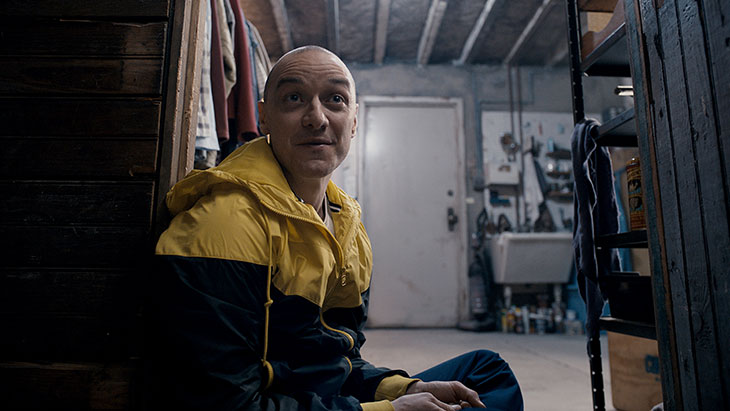
Split is an M. Night Shyamalan film. That might color your opinions of this movie regardless of whatever is said from this point forward. That being said, I personally think this is one of Shyamalan’s best films and EASILY the best film he’s made in over a decade (I know that isn’t saying much, but stay with me). Unfortunately, I almost feel that this film would actually be a lot better if it wasn’t a Shyamalan movie, and it also features what may end up being the most divisive twist ending in Shyamalan film history. I won’t spoil it, but I will discuss its import to critiquing the movie. I think you should see it, but beyond that, I am very… torn about this film.
The film stars Ana Taylor Joy as a teenage girl who gets abducted alongside two classmates. She wakes up with them in a strange room and is introduced to James McAvoy playing a character with 23 distinct personalities. It is revealed that the girls were abducted to serve as sacrifices to something called “The Beast.” In order to escape, the girls have to to interact with the many different faces of this person, each with their own interests, goals, and rules for the girls to follow, and look for a way out. Meanwhile, one of McAvoy’s other personalities keeps contacting his therapist, Dr. Karen Fletcher (Betty Buckley), and she has to figure out which personality she is talking to at any given time. The clock is slowly ticking away until the arrival of The Beast.
Easily one of the biggest benefits of this movie is that it is easily one of the simplest plots of any of Shyamalan’s films. Regardless of what you think of Shyamalan’s earlier films, most of his more recent content is either far too complicated (After Earth, Lady in the Water) or just too ridiculous to be invested in (The Happening, The Visit, Devil). In this film, Shyamalan’s past failures seem to have convinced him that he needs to get back to basics and return to what he does best. As such, like all of Shyamalan’s good films, like Unbreakable or The Sixth Sense, Split is a slow burn suspense thriller clad in muted city colors and starring damaged characters.
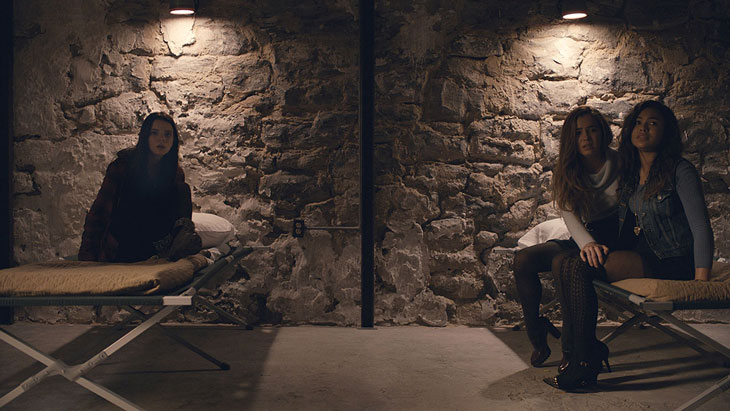
As good as all of this is, the keystone that holds the film together is James McAvoy’s performance as the kidnapper. He gives clear physical ticks, accents, speech tendencies, and other clear distinctions between the various personalities. While the film’s claim that there are 24 personalities is slightly erroneous since the majority of them get one line at most, there is no denying that McAvoy is fully committed to this performance to the point that people can believably tell the difference between different personalities based on how he acts or transitions. There are points where the personality shifts are too ridiculous (particularly in the climax) and some scenes are just hilariously awkward rather than scary, but the film still works because you buy his performance. Ana Taylor Joy also gives it her best effort despite the deliberate limitations on her character’s personality (and the same goes for her younger stand-in in flashbacks), but her character suffers from Shyamalan’s worst writing tendencies.
The problems arise from the fact that returning to basics has not prevented Shyamalan’s directorial tendencies from damaging the film. While the film is largely very well filmed and directed to create tension and atmosphere, the limits of Shyamalan’s directing techniques become readily apparent. Actors constantly talk directly to the camera, and panning shots across the set are used to establish surprises and maintain a tense mood. These are mostly effective, but there are random scenes of tracking shots filmed deliberately behind the actor or conversations going on off screen while something more artistic or thematically interesting is shown on the screen. The acting mostly works, but there is still a tendency towards unintentional awkwardness or overly on-the-nose dialogue from many of the actors.
The awkwardness is not helped by Shyamalan’s tendency to write nothing but clumsy, plot driven dialogue or deliberate quirkiness. There is a scene that occurs early in the movie where Ana Taylor Joy tells one of the other girls to pee on herself to protect herself from the kidnapper. You have no idea why she said that, how she knew it would work, or how it ties in to her role in the plot and it is never brought up again. Those clunky forced plot points are riddled throughout Shyamalan’s films and this one is no different. Also, aside from McAvoy, Buckley, and Joy, there are other actors but they are given nothing to do. The other two girls are strictly there to serve as cannon fodder and as a narrative juxtaposition to Ana Taylor Joy and any scenes with them fall flat because these characters are never given any personality beyond dumb girls in a stereotypical horror movie plot (the film lampshades this aspect of their characters, but never expands beyond it). Also, they are used for some of the film’s sleazier elements, like having them walk around in their underwear or getting their entrails eaten, and these elements do not match the tone of the rest of the film. All of this is silly, uneven, and more than a little tone deaf, but none of that compares to the film’s climax.
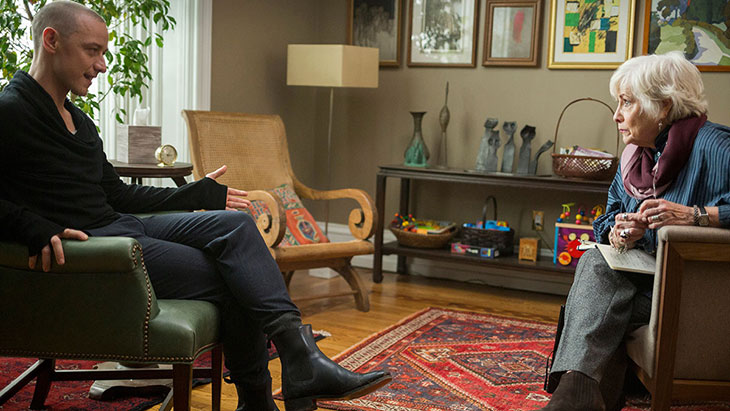
This is the part of the film that I am the most torn on. On the one hand, it is a gloriously insane sight to behold. You will not believe how absurdly far Shyamalan is willing to take his premise of a man whose biology can change as a result of his personality. It is easily one of the most memorable climaxes in a Shyamalan film ever. On the other hand, it breaks the film. While I know some people really like how this film concludes, for me it utterly breaks immersion. It turns what was once a relatively effective suspense thriller into a cartoon horror movie. It features stupid plot twists, a lame cop out ending meant to tie together the film’s mostly pointless subplots, and McAvoy hamming up his performance to such a degree that you cannot do anything but laugh at his antics. Furthermore, and this is the big twist of the film, Shyamalan attempts to justify this absurd ending in a way that left me reeling, but not for the right reasons. Some people love this twist, but to me it felt like an attempt to retroactively justify all of the absurdity he had built into this film’s climax. For all of Shyamalan’s talent behind the camera, he clearly needs someone else to write his films. Someone who understands how people act and how plot structures work.
In spite of all of this, I still think you should see the movie. Shyamalan, regardless of the quality of his films, is a singular and unique voice as a filmmaker and you will rarely ever be bored by the content of his films. If only he could outgrow his ego and grow as a filmmaker. As good as he is, this film still feels dated because Shyamalan has been using the same film tricks since Unbreakable. It still works for the most part, but Split may prove that Shyamalan is at best a talented one trick pony. Either way, see this film so I can have someone to talk about this film’s ending with.

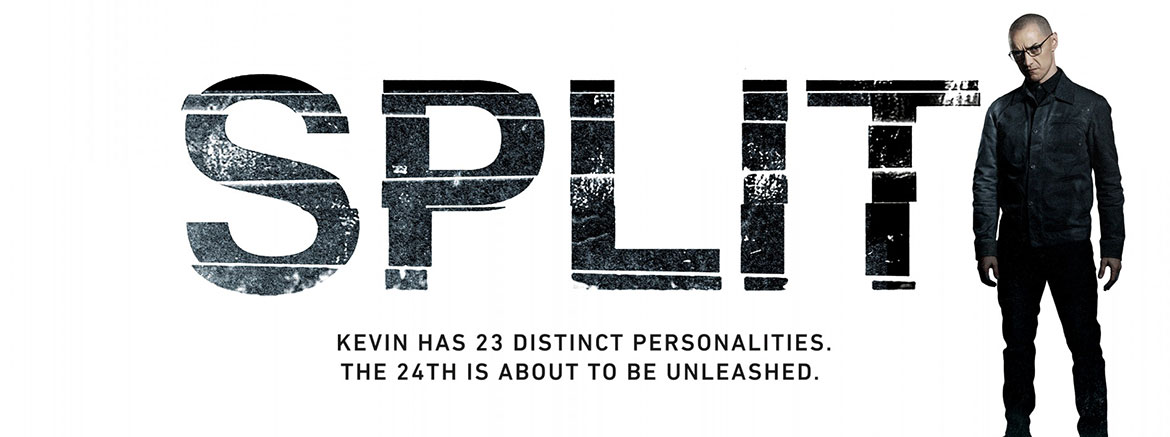
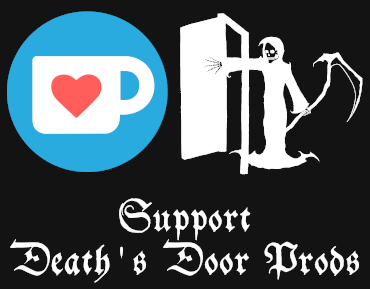


Add comment